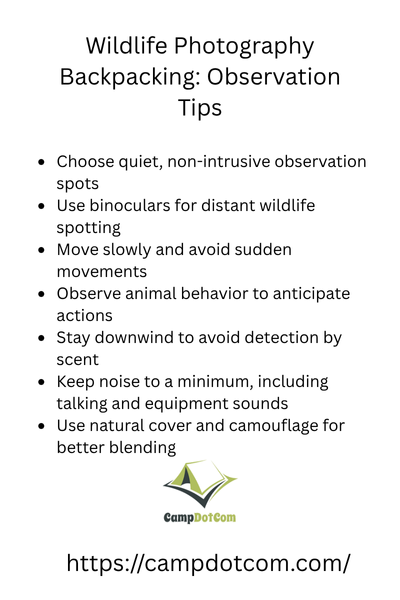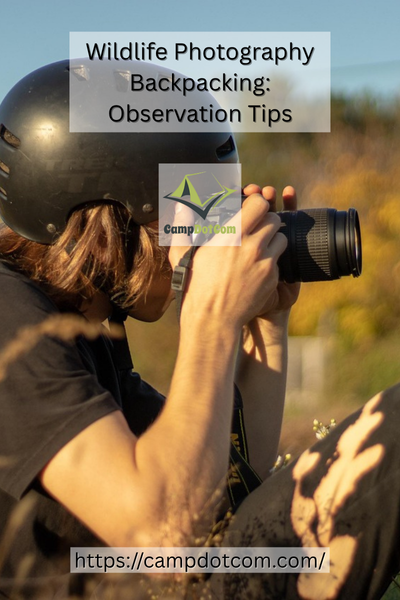There’s something magical about stepping into the wilderness with nothing but your camera and a backpack, ready to capture the untamed beauty of nature.
Wildlife photography backpacking combines two thrilling adventures into one—exploring the wild and freezing breathtaking moments in time. If you’ve ever dreamt of snapping that perfect shot of an eagle soaring overhead or a fox curiously peeking out from behind a tree, then you’re in the right place.
Let’s talk about some essential observation tips to make your wildlife photography backpacking trips unforgettable.
As an Amazon Associate, I earn from qualifying purchases. Some of the links in this article are affiliate links. This means that, at zero cost to you, I will earn an affiliate commission if you click through the link and finalize a purchase.
Read More About Wildlife Photography Backpacking

The Art of Blending In
Ever notice how wildlife seems to vanish the moment you take a step? Animals have a sixth sense for detecting human presence, which makes staying unnoticed a key skill.
I learned this the hard way on my first wildlife photography backpacking trip. There I was, clunking through the underbrush like a lost hiker, wondering why every bird and deer fled at my approach. Turns out, subtlety is everything.
- Wear neutral, earth-toned clothing to blend into your surroundings.
- Move slowly and deliberately, like you belong in the landscape.
- Avoid direct eye contact with animals—many interpret it as a threat.
By practicing patience and stillness, you become part of the environment rather than an intruder.
Timing is Everything
Wildlife doesn’t run on our schedules. If you want to capture stunning shots, you have to work with nature’s rhythm. Early mornings and late afternoons are the golden hours—not just for lighting, but because animals are more active.
More Things to Know About Wildlife Photography Backpacking

I remember one crisp morning when I set out at dawn, half-awake but determined. Within an hour, I found myself watching a family of otters playing along the riverbank. If I had stayed in my tent, I would’ve missed that magical moment.
Plan your outings around sunrise and sunset for the best light and the most action. Midday often means harsh light and hidden wildlife, so use that time to scout locations or take a break.
Listen Before You Look
Your eyes are not your only tool for spotting wildlife. Your ears are just as important. The rustle of leaves, a distant call, or the sudden silence of birds can all signal an animal’s presence.
Once, while hiking deep in a forest, I heard an odd, rhythmic knocking sound. I stopped, listened, and soon spotted a woodpecker hammering away at a nearby tree. If I had just been scanning with my eyes, I might have walked right past it.
Take time to pause and listen. Nature has a way of revealing itself if you are paying attention.
The Waiting Game
Wildlife photography backpacking isn’t about chasing animals—it’s about letting them come to you. Some of the best photographers spend hours (even days) in a single spot, waiting for the perfect shot.
I’ll admit, patience isn’t my strongest virtue. But the first time I settled in and let nature unfold around me, I was rewarded with a once-in-a-lifetime shot of a bear catching salmon mid-air. That wouldn’t have happened if I had been stomping through the woods hoping to “find” something.
Find a promising location, get comfortable, and let the wildlife move naturally. Sometimes, the best action happens when you least expect it.
Camera Readiness: Stay Sharp!
You never know when the perfect shot will present itself, so your camera needs to be ready at all times. I’ve lost count of how many times I’ve missed a shot because I was fumbling with settings. Here’s what I learned:
- Keep your camera on and set to a fast shutter speed for sudden movements.
- Use a zoom lens so you can capture distant subjects without disturbing them.
- Learn your camera settings inside and out, so adjustments become second nature.
Practice quick-draw photography—see something? Frame, focus, and shoot in seconds.
Respect the Wild
Finally, remember that wildlife photography backpacking is about appreciation, not disruption. It’s easy to get caught up in the excitement of capturing a rare moment, but no photo is worth stressing an animal or damaging its habitat.
Follow the Leave No Trace principles, keep a respectful distance, and always prioritize the well-being of nature over the shot.
One time, I watched another photographer get a little too eager and creep up on a moose. The moose didn’t appreciate the intrusion and promptly charged. Let’s just say that guy learned a valuable lesson about personal space that day.
Wrapping Up Making the Most of Wildlife Photography Backpacking in the Wild
Wildlife photography backpacking is more than just snapping pictures. It is an immersive experience that connects you to nature in a way nothing else can. The key is patience, awareness, and respect. Blend into the landscape, listen more than you look, and be ready at all times. Most importantly, enjoy the journey. Whether you capture the perfect shot or simply revel in the beauty around you, every trip into the wild is worth it.
Now pack up your gear, lace up your boots, and get out there. Who knows what incredible shots await you on your next adventure?
